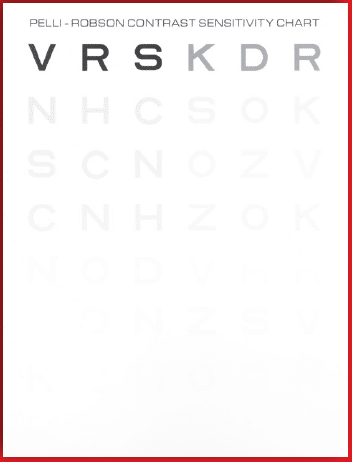
PV News – September 2010 – Precision Vision Introduces the New SK Read Testing Chart – Precision Vision
IN THE NEWS
Precision Vision would like to introduce to you to the New SK Read Testing Chart. The SK Read is particularly useful for any eye care professional that’s treating macular diseases because it shows them the benefits of their macular treatments.
Precision Vision Introduces the New SK Read Testing Chart
A Momentous Development in the Field of Low-Vision Testing
SK Read Test Benefits Practitioners Caring for Patients with Macular Degeneration and Other Eye Diseases Affecting the Central Visual Field
At this very moment, you are performing a basic action that most of us take for granted: reading. Countless others struggle with this activity not because they never learned how to read, but rather because they suffer from macular degeneration or other hereditary or neurological eye diseases.
Today, a major innovation in the field of low vision testing tools is changing the way practitioners measure and monitor the progress (or decline) of patients with low vision due to serious eye diseases, such as age-related macular degeneration (AMD), diabetic retinopathy, advanced glaucoma, retinal vascular occlusion, neurological diseases, or other factors that lead to a central field disruption.
The SK Read Test, named for the Smith-Kettlewell Eye Research Institute, was specifically developed to test reading in the absence of contextual clues, according to Donald C. Fletcher, M.D., of the Frank Stein and Paul S. May Center for Low Vision Rehabilitation, the California Pacific Medical Center and the Smith-Kettlewell Eye Research Institute.
Dr. Fletcher’s specialties in ophthalmology of low vision rehabilitation and retinal disorders, allows him to witness first-hand the frustration of his patients with partial sight. For people with AMD, reading is the main activity where they have difficulties, according to Dr. Fletcher.
“Reading is best assessed by actual reading, not looking at letter charts,” said Dr. Fletcher. “My main goal in developing the SK Read Chart was to improve the way I test patients with this particular problem.”
Dr. Fletcher points to the MN Read charts as excellent testing tools for reading speed vs. text size evalutation. The charts have patients read 10- to 12-word sentences starting with very large text at the top (8M, which is 8 times newsprint size) and ends with the bottom line at 0.13M (well below newsprint size). If a person has difficulty reading at 4M, then the practitioner may recommend a 4M magnifier, and so on.
“I began to frequently notice that people would sometimes stall as they were reading the MN Read chart. I could hear by the pattern of their speech that they were missing letters and words. This is caused by scars or central defects in the retina called macular scotomas. About 90 percent of people with AMD seen in a low vision rehabilitation clinic have macular scotomas, or ‘blind spots’,” he said.
While the existing MN Read test is excellent for reading speed vs. text size determination, it does not demonstrate where the scotomas are located in the patient (a left or right scotoma). Macular scotomas are tremendously significant for reading and thus the SK Read adds a new dimension to the information obtained by the MN Read.
“The brain is excellent at perceptual completion, meaning it can basically ‘fill-in-the-blanks’ when letters are missing from words,” said Dr. Fletcher. Because the brain is so good at this task, traditional reading charts such as the MN Read allow the patient to “cheat” and guess what the words are based on the context of the sentence.
For example, an actual sentence on an MN Read testing chart appears as the following:
My father takes me to school every day in his big green car.
If a patient’s scotoma results in him missing the letter g on the word green, then he will keep reading it until the sentence makes sense (that is, “reen” doesn’t sound right, so it must be “green”). He may have inferred the word correctly, but his scotoma is not caught, which is a critical oversight in this process.
“Once again, the main reason magnifiers don’t always work on patients with AMD is because they will not see their blind spots. The patient remains completely unaware of them and so these black holes in space go unnoticed. This is the very reason why they often have an unsuccessful outcome with equipment such as magnifiers,” said Dr. Fletcher.
Over the past two years, Dr. Fletcher conducted scores of research to develop the SK Read test. He purposefully wanted to create a test that looked like the MN Read test, which meant it needed to be the exact size and layout, and administered in the same manner.
The major difference with the new SK Read test is that it intentionally uses random words and letters so it does not offer any clues to the patient.
For example, an actual “sentence” on an SK Read chart appears as the following:
as c yes gold d edge ball swing r monkey theme y water h run g
The above grouping of words makes absolutely no sense together. That’s the whole point, according to Dr. Fletcher.
If the g in the word gold was disappearing, the patient would say “old.” If the e in the word theme disappeared for the patient, he would say “them.”
“This is a breakthrough test because there’s no sentence with a context. We can now accurately determine – within mere minutes – where a scotoma lies within the patients’ macula because we can see how the scotomas are affecting their reading performance,” said Dr. Fletcher.
Instant Results
With the SK Read low vision test, patients are unaware that they’ve made mistakes (i.e. they didn’t see the missing letters). When the test is completed, practitioners can go over the test with patients.
“There’s often an ‘a-ha’ moment as the patients begin to understand why they were missing letters,” continued Dr. Fletcher. “The SK Read is quick and easy to administer practically anywhere, and it immediately tells you what’s functioning properly and what isn’t. This test shows you how an eyeball works in real-world activity.”
The SK Read is particularly useful for any eye care professional that’s treating macular diseases because it shows them the benefits of their macular treatments. It tells practitioners tremendous information about the integrity of the macula. While you can look at the thickness of the macula by means of an OCT, you cannot assess if it’s working or not. When you treat macular diseases, you’re interested in more than just the fovea. Have you saved a sufficient span of macula to allow reading words (not just letters)? This test may demonstrate a very real benefit of macular treatments not demonstrated by single letter acuity or retinal thickness.
Benefits of using the SK Read by Precision Vision:
- Ease of use: It’s portable, quick and simple to administer. It has great value in combination with the MN Read, giving additional important information.
- It’s a new beginning: It offers a good starting point independent of magnification (you don’t need a magnifier to do this test).
- It provides immediate results: Practitioners can instantly explain how their patients’ blind spots are affecting their daily activities and explain if there’s a pattern (left-side scotoma, right-side scotoma, etc.).
- It’s effective: Patients make 20-30 times more “mistakes” on the SK Read test versus the MN Read test (a positive development in illustrating their blind spots).
- It’s Sensitive: A person can have 20/40 or 20/60 visual acuity, but they can still have reading difficulty; practitioners can no longer use visual acuity as a reliable reference.
- It’s a Monitoring Tool: If practitioners are aiming to monitor the effectiveness of their treatments, the SK Read series of charts will accomplish that goal.
- It’s Affordable: The SK Read charts start at only $135.
PRODUCT PROFILE
SK Read
The SK Read Test was developed to assess the reading performance of English speaking adults who may be encountering visual field defects. It’s designed to allow words to be easily confused and facilitate the verbalization of mistakes encountered while reading. Blocks of text range in size from 8 M units down to 0.4 M units. Each block of text contains 6 single letters chosen from the 1000 most commonly used words in the English language.
Colenbrander Reading, Intermediate and Computer Chart (2 card set)
Conventional, high-contrast letter chart acuity captures only one aspect of visual performance. Low contrast acuity is equally important for activities of daily living, since most everyday objects have less than black-on-white contrast, are larger than the smallest letters seen on a letter chart and are seen at various intermediate distances.
- Calibrated for 40 cm (16 in), 63 cm (25 in), 100 cm (40 in)
- Measures 8.5″ x 11″
- Includes complete instructions and recording sheet
- Uses 10% calibrated Contrast Sensitivity level with Acuity
- Designed by: Dr. August Colenbrander
SEE PV
Upcoming Tradeshows
Visit Precision Vision at the following tradeshows. If you are attending one of these tradeshows and want to avoid unnecessary shipping costs and delays, we’d be happy to bring small portable products to the meeting. Place your order online or call us at 800-772-9211. Just be sure to tell us which tradeshow to hold the products for.

Share Your Stories With Us!
Precision Vision® wants to hear your stories. Tell us how you are impacting the industry. Do you have an interesting story to share about a Precision Vision® product? Contact us and we may use it in a future newsletter.





